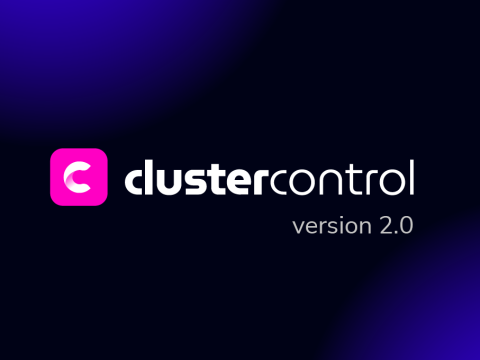blog
ClusterControl’s major version 2.0 release enhances its fit for modern workloads

We’re thrilled to announce the release of ClusterControl (CC) v2.0! This major release introduces a host of exciting new capabilities designed to scale and enhance ClusterControl’s fit for modern workloads and applications.
ClusterControl’s evolution – “Old dog with new tricks”
ClusterControl v2.0 marks a significant milestone and evolution from its inception in 2011, supporting MySQL NDB Cluster. With over 14,000 successful deployments, the orchestration platform now supports the most popular open-source databases and essential tools to deploy, monitor, and scale database nodes in any environment.
Let’s dive into the details to help you get up to speed with ClusterControl v2.0.
ClusterControl’s Operations Center (Ops-C): built to scale your deployments
Have you outgrown your single CC installation or need a multi-tenancy solution? CC Ops-C enables you to effectively manage multiple CC controllers and scale database nodes through a single web application.
Key functionality of Ops-C:
- Horizontal scaling: Expand your capacity to handle growing workload demands by adding controllers.
- Central web application: Manage multiple CMON controllers through a user-friendly ClusterControl interface.
- Integrated controller dashboard: Resolve database issues faster with an aggregated dashboard providing detailed insights into controllers’ statuses, ongoing jobs, alarms, backups, and the status of clusters and nodes.
CC Ops-C supports multiple use cases:
- Scale your ClusterControl installation: Expand your single ClusterControl installation when the number of managed database nodes exceeds the server hardware limit or the capacity of the CMON controller.
- Internal DIY DBaaS: Grow your internal team’s capabilities with an Operations Center that simplifies tenant isolation and enables the seamless scaling of CC.
To help guide you through the set up process, refer to our docs.
ClusterControl better complements DevOps teams with modern environments
ClusterControl has lowered the barriers to implementation for DevOps teams, simplifying integration into Kubernetes environments and Terraform workflows. Let’s explore these enhancements designed to support your applications and teams.
1. ClusterControl’s Kubernetes Helm Chart
We designed our Helm Chart to provide everything you need to quickly get ClusterControl up and running in a Kubernetes cluster.
Why integrate ClusterControl into your Kubernetes environment?
- Easy installation process: Deploy ClusterControl in your Kubernetes environment with just a few commands.
- Standardization of your full-lifecycle ops: Simplify and reduce your workload with access to powerful monitoring, failover, and alerting capabilities.
- Customization at your fingertips: Take advantage of ClusterControl’s built-in functionalities or integrate your preferred monitoring stack to effectively manage open-source databases.
For more details, read our Helm Chart docs and blog.
2. ClusterControl’s Terraform Provider
Our Terraform Provider allows users to easily build provisioning workflows into the deployment sequences of their ClusterControl-managed databases. For DevOps teams using ClusterControl and Terraform, this will further reduce the daily operational load and complexity by helping to streamline processes.
Terraform users gain several advantages, including:
- Faster deployment: Automate the provisioning of database clusters across public and private clouds tied to your application infrastructure deployments.
- Greater portability: Facilitate an environment-agnostic implementation and switch between providers and environments wherever you want.
- Seamless integration: Integrate ClusterControl with your existing Terraform manifests and CI/CD pipeline environments.
For more info, check our docs and blog for all the details.
Explore more updates in ClusterControl v2.0
ClusterControl v2.0 also includes support for Redis Cluster and major version support for MongoDB 7 and Debian 12. For more info, see our Redis Cluster docs and changelogs.
Wrapping up
ClusterControl 2.0 introduces powerful capabilities tailored to optimize and scale your modern workloads. Stay tuned for our next release, featuring enhancements to Redis Cluster, additional support for open-source databases, and an upgraded version of PostgreSQL.
New to ClusterControl? Try our Enterprise edition free for 30 days and receive technical support to guide you throughout your journey.




